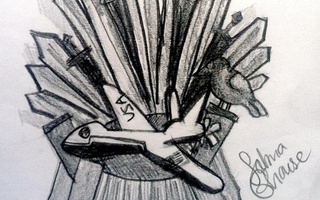Paging Peter Sellers. Suddenly, it seems, a whole lot of people have learned to stop worrying and love the drone. With the same deadly precision they claim for their weapons of choice, defenders of drones—also known as unmanned aerial vehicles—have been gleefully shooting down the arguments of any who dare criticize their tactics. “The future of how you use these unmanned systems or remotely piloted systems is really unlimited,” contends one lieutenant general, speaking for them all.
The recent U.S. takeout of Taliban big cheese Baitullah Mehsud has predictably fired up these drone proponents, who see it as a clear-cut success story and a case for upping the number of UAVs. What’s more surprising, perhaps, is that the counterarguments have been so few and so thin. It’s the specifics, rather than the supremacy of the drone approach itself, that have come under attack. Pakistanis decry U.S. counterterrorist strikes in their country as a “violation of sovereignty” (apparently, contracting out assassination missions to third parties isn’t their preferred method), but these protests really boil down to wanting the missiles in their own hands. Soft-hearted lefties contend that drones take out innocent civilians along with targets. But justifiable as these concerns are, as tracking software grows more advanced and imaging resolution more clear, the purely mechanical aspect of unmanned warfare will take care of itself.
So how to reckon with that nagging feeling in the gut when confronted with the statistics—that last year the U.S. military employed twice as many drones as it did manned fighter planes, that the total number of military drones has increased drastically from 167 in 2001 to 5,500 today, that under Obama’s presidency alone we’ve already ordered dozens to eliminate al Qaeda and Taliban operatives? CNN.com blithely reports on one Major Morgan Adams, who pilots a Predator sending Hellfire missiles into Iraq and Afghanistan: “He kisses his wife goodbye, drives to Creech, a tiny desert air force base in Nevada, and within minutes could be killing insurgents on the other side of the world.” Now soldiers can go about the dirty business of war and be home in time for dinner.
It’s precisely this lack of personal investment that makes the new emphasis on drones such a radical shift in the way war is waged. Despite the rhetoric employed when we send our soldiers packing, we’ve come a long way from the ideal of war as a forging ground for masculine ideals: the moral enrichment found on Cato’s battlefields, the two Novgorod commanders vying to outdo one another in valor in “Alexander Nevsky.” Even in Vietnam, when these models of individual heroism largely broke down—no longer could one line up manfully, toe to toe with the enemy—American forces were still provided with opportunities for bravery as they navigated the jungle under constant threat of sniper fire.
But when a physical presence becomes superfluous, such subtle considerations—considerations that made war as much about cultivating our own behavior as about taking out “targets”—don’t play a role at all. And therein lies the danger. Policymakers in their swivel chairs at the Capitol have much in common with children afraid of the dark; the richness of their imagination often outstrips the banality of the reality. The capability of dispatching a robot with no harm to U.S. persons isn’t necessarily a condition for joystick diplomacy, but it makes overreacting to threats a very distinct possibility. So it is that even P.W. Singer, a defense analyst at the conservative Brookings Institution, warns the shift to unmanned vehicles could make us “more cavalier” to the use of force.
Indeed, all the recent uproar over Guantanamo prisons and black sites has obscured the fact that drone targets also don’t get court trials, judges, or hearings. (Until recently, the Obama administration used Blackwater—also responsible for Gitmo planning—to help organize its drone operations.) It’s hard to think of a more bizarre and troubling contradiction than shutting down the number of torture programs while stepping up the number of remote-control executions. Keeping our own boys safe is a laudable goal, but not if it comes at the cost of due process or credibility abroad.
Comeuppance will arrive sooner or later, though. If our targets don’t turn the drones back on us—more than 40 countries are working right now to develop drone technology—the robots themselves may have their way. The Air Force just released its Unmanned Aircraft System Flight Plan, which estimates that autonomous aerial bots will replace all manned aircraft in the country by 2047. And in June, leading figures in the artificial intelligence community convened at the Asilomar Conference Grounds in Monterey Bay to discuss the dangers of technologies like drones for humans. Sitting on the oceanfront, surrounded by pristine forests and sandy white beaches, they mulled over such “I, Robot” scenarios as super-intelligent machines destroying the world in self-defense. Forget Dr. Strangelove—we need Will Smith.
Jessica A. Sequeira ’11, a Crimson associate editorial editor, is a social studies concentrator in Winthrop House.
Read more in Opinion
Husbanding Harvard’s ResourcesRecommended Articles
-
Karthinking About DronesAs more, varied, and better drones become ever more useful substitutes for riskier methods of force projection, diplomacy could lose much of its attractiveness.
-
God Bless DronesThese strikes are not only wiping out threats, but they are also preventing present insurgent forces from organizing themselves effectively.
-
Our Very Own Campaign of TerrorThe US needs to significantly reform its use of drones in the region, if not completely abolish it.
-
Assessing a Legal Framework for Drone StrikesThe U.S. needs to develop an effective balance between efficient systems of eliminating targets and respect for the constitutional rights of terrorists, whatever they may be.
-
 Should The United States Use Drones for Military Operations?
Should The United States Use Drones for Military Operations? -
 Game of Drones
Game of Drones













